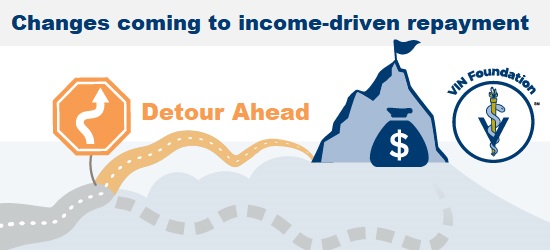Federal student debt proposal would change REPAYE, phase out PAYE
Buried in a sea of federal student loan announcements and changes over the last few years was the promise of a new income-driven repayment plan. Now we know how parts of that promise will be implemented when the pandemic forbearance benefits end this summer.
The Biden administration on Jan. 10th first posted its proposed changes to income-driven repayment. Turns out, it’s not a new plan but instead, modifies the existing Revised Pay As You Earn (REPAYE) plan and phases out two others. The final version of this proposal was released on June 30, 2023 after the Supreme Court ruled against the one-time cancellation benefit.
Listen to the recent podcast episode on the latest student loan changes:
Summary of Major IDR Changes Affecting Veterinarians:
- Initial updates to REPAYE will begin after the pandemic forbearance benefits end, August 31, 2023. REPAYE will be renamed Saving for a Valuable Education (SAVE). Anyone using REPAYE will automatically be put into the SAVE plan.
- The SAVE discretionary income will protect 225% (up from 150%) of the HHS Poverty Guidelines in your calculated payment resulting in the lowest monthly payment of any income-driven plan.
- In 2024, SAVE will adjust your payment to be between 5%-10% of your discretionary income, depending on your proportion of undergraduate debt to graduate school debt. Most veterinarians can assume a payment of 10% of discretionary income as the majority of debt is incurred during veterinary school.
- SAVE will no longer charge unpaid interest each month when your payment is less than the monthly interest accrual. Essentially, SAVE raises the current REPAYE 50% unpaid interest subsidy to 100%. This signifies the end of growing student loan balances for anyone using SAVE.
- SAVE will now allow borrowers who file their taxes separately to calculate their payment based only on their taxable income.
- Existing terms of REPAYE would be automatically amended. No one using REPAYE currently will need to do anything to receive the SAVE benefits.
- For all IDR plans, any married borrowers filing taxes separately and using ICR, IBR, PAYE, or SAVE will no longer have their spouse included in the family size.
- Limit PAYE eligibility to anyone eligible for and using PAYE before July 1, 2024.
- Limit ICR eligibility to anyone using ICR before July 1, 2024 or to borrowers with a Parent PLUS loan.
- Expanded provisions for helping certain periods of deferment and forbearance to count towards forgiveness.
- Starting in 2024, progress towards forgiveness does not fully reset when a borrower consolidates loans that have qualifying forgiveness time. Forgiveness time in a Direct Consolidation Loan will be a weighted average of the loans included in the consolidation.
- Anyone who applies for the new version of IBR (IBR 2014) can have no more than 60 months in REPAYE (SAVE) after July 1, 2024 in order to be eligible to switch to IBR 2014. This is in addition to the partial financial hardship test that exists for IBR.
The VIN and VIN Foundation Student Debt Team Wizards have recently added the SAVE into the Student Loan Repayment Simulator. In the coming weeks, REPAYE will be removed from the simulator reflecting that fact that anyone using REPAYE now or in the future will follow the SAVE rules and regulations. PAYE will remain in the simulator as there will be thousands of borrowers who will still benefit from choosing and keeping PAYE as their student loan repayment plan.
While the changes will simplify some aspects of repayment, it’s going to be more confusing before it gets better. With the ongoing one-time forgiveness count adjustment, the restart of interest and payments this summer and fall, and the changes to IDR, it will be harder than ever to keep things straight. Bear with us as we work to break some of these things down into digestible segments. It’s not easy. We’ll link to certain concepts we have covered elsewhere and expand where we can. There’s no way around the fact this requires some curiosity and patience. Ask a lot of questions and if you need help, reach out to VIN Foundation.
Mathematically, they succeeded in creating a SAVE plan that will have the lowest minimum monthly payment for all income-driven plans. However, that is not the only metric borrowers care about.
As stated in their own discussion of the changes, the Department of Education (ED) sought to address three major frustrations with income-driven repayment: the length of time to reach forgiveness, repayment complexity, and not seeing any progress with consistent payments. Unfortunately, they only succeeded in decreasing time to forgiveness for undergraduate borrowers. The other frustrations will remain, while adding a few new ones for borrowers to navigate.
For graduate school borrowers, SAVE will have a maximum repayment period of 25 years before reaching forgiveness. That now sets up an emotional and mathematical battle between SAVE and PAYE or IBR 2014 for many veterinarians, depending on the plan eligibility for a particular borrower. ,
Here’s the conundrum: Do you want a lower monthly payment and no unpaid interest accrual for 25 years or a slightly higher monthly payment with unpaid interest accrual for 20 years?
Those lucky enough to be eligible for IBR 2014 can have the best of both worlds, but only for five years since IBR 2014 will limit eligible users to those who have only 60 months of payments or less using SAVE.
For those who are not eligible for either PAYE or IBR 2014, SAVE is a huge improvement. Many married veterinarians for years have been stuck with old IBR (IBR 2009) either because they didn’t know about REPAYE or they were married and needed to use IBR 2009 to exclude their spouse’s income. SAVE will make IBR 2009 an obsolete plan. Only those who have a very beneficial IBR 2009 minimum payment coming out of the pandemic forbearance benefits should wait to switch over to SAVE the next time they are due to renew. All other IBR 2009 users should run to apply for SAVE.
IDR modifications: Winners
The biggest winners are undergraduate borrowers. Their payment will be 5% of their discretionary income and their loans will be forgiven after 20 years of payments. Undergraduates with balances of $12,000 or lower will see their debt forgiven after 10 years of payments.
Anyone using SAVE will see a lower monthly payment compared to other income-driven plans. The discretionary income formula will now protect a higher share of your taxable income (225% of the federal poverty guidelines). For borrowers like myself who are only eligible for the older version of Income-Based Repayment (IBR 2009) or REPAYE, SAVE will automatically make the best available repayment option to me better by lowering the monthly payment, applying a 100% unpaid interest subsidy, and increasing the flexibility for married borrowers. It will also be easier to project my future forgiven balance since I know it will no longer grow. The maximum amount that could be forgiven is equal to my current total balance.
Married borrowers not eligible for PAYE or IBR 2014 who were not using income-driven repayment or who are using old IBR (IBR 2009) to keep their payment lower will benefit from SAVE. Unlike the current REPAYE, married borrowers will have the option to exclude their spouse’s income if they file their taxes separately.
Graduate school borrowers who are eligible for IBR 2014 are also winners. SAVE will allow them to benefit from a dual income-driven plan approach. The lower SAVE payment and the improved unpaid interest subsidy will save borrowers money while their income is lower. Then, switching from SAVE to IBR 2014 will help them to receive forgiveness sooner (if they are projected to reach forgiveness). The catch – you can only switch to IBR from SAVE if you have less than 60 payments in SAVE starting after July 1, 2024. That means you have to figure out pretty quickly after graduation if you’re likely to reach forgiveness or not. Most people don’t have that kind of clarity in that short amount of time.
Public Service Loan Forgiveness (PSLF) hopefuls are also winners in the modifications. The lower monthly payments in SAVE helps increase the PSLF benefit, particularly for most married borrowers. Anyone who is confident that their career path involves public service will significantly benefit from using SAVE for their duration of repayment.
Loan servicers are unlikely winners in the new modifications as well. Phasing out one of the 20-year forgiveness plans will push more borrowers into repayment longer. And more confusion seems to allow the loan servicers to charge more to taxpayers for providing terrible service to borrowers. They have already been continually terrible in conveying the changes to borrowers as we prepare for the restart of interest and payments. Double-check everything your loan servicer tells you.
IDR modifications: Losers
Some graduate school borrowers are going to be losers in the proposed changes, despite some of the improvements made. For years, the Dept of ED has added “new borrower” requirements that determine who is allowed to use certain plans, like PAYE or IBR 2014. The most favorable plans generally have shorter timelines to forgiveness. For example, PAYE and IBR 2014 require 20 years of payments vs. 25 years for ICR, IBR 2009, and REPAYE to reach forgiveness for those with a single graduate school loan. I graduated from veterinary school in 2012 and do not meet any of the new borrower requirements. Somehow, it is OK to allow not-so-new borrowers like myself to be in repayment longer than new borrowers with the same loan types.
And now, borrowers who are eligible for PAYE, but not IBR 2014 (due to the arbitrary new borrower rules) will be forced to choose between a shorter repayment period with a higher payment and unpaid interest accumulation vs. a longer repayment period with a lower payment and no unpaid interest accrual. Still others will throw their hands up because of the confusing nature of federal student loans and lose access to PAYE altogether if they are not using it by the arbitrary phase-out date.
It’s hard to overstate how helpful PAYE is for graduate school borrowers. Unfortunately, knowingly or unknowingly, many are not using PAYE. By phasing it out before they get a chance to use it, the Dept of ED will create further frustration when these borrowers find themselves left with SAVEas their best remaining repayment option. This includes borrowers who have either been misinformed, have not yet discovered PAYE, or who are still in school, planning to choose PAYE but may find it unavailable by the time they graduate and can apply for it.
IBR 2014 and PAYE New Borrower Requirements:
PAYE: To be a new borrower for PAYE, your first federal student loan must have been received after October 1, 2007 and you must also have received at least one loan after October 1, 2011. Alternatively, if they received a loan before that date, then the loan must have been paid in full prior to borrowing again after Oct 1, 2007.
New IBR or IBR 2014: Eligible Direct Loan borrowers must have received their first student loan after July 1, 2014. If they received a loan before that date, then the loan must have been paid in full prior to borrowing again after July 1, 2014.
Finally, the proposed changes will set up some new traps for borrowers. Loan servicers have been horrendous at administering the federal student loan repayment plans. The mistakes and misinformation are staggering. The proposal to phase out PAYE and ICR and not allow borrowers who were previously using those plans back into them is a trap. Phasing out plans contractually obligated when borrowers received loans is wrong. At minimum, I hope the ED will provide an appeal process in the event a borrower is mistakenly taken out of a plan they can no longer get back into. If not, even more responsibility will be thrust onto someone using PAYE or ICR to make sure no mistakes are made going forward. History has not shown those expectations to be realistic.
Another trap is set by the 60 monthly payment limit to use IBR 2014. For new borrowers eligible for IBR 2014, there is a strategic case for using SAVE early in repayment, then switching to IBR 2014 after exhausting the benefits of SAVE. The most clear example is for veterinary internship and residency training. In the best case scenario, that takes 4 years, not leaving much leeway for an extra year or two if necessary. Giving a borrower only 5 years in SAVE before needing to switch to IBR 2014 to receive forgiveness sooner is unnecessarily complex and punitive.
Once again, more onus is thrust on the borrower to be savvy enough to know and switch before reaching that limit (as if advanced medical training is hard enough). If they do not act in a timely manner,they will lose access to IBR and end up in repayment longer.
What should you do now?
Confirm your current and eligible income-driven repayment plans. You may think you’re using PAYE or REPAYE, but double-check. It’s not uncommon for us to see borrowers who say they are using one plan and their student aid file shows something else. It’s an easy mistake to make with all of the different options.
The VIN Foundation has a variety of free tools to help you conduct a student loan “physical exam.” Visit the Student Debt Center and use the My Student Loans tool.
Next step, crunch the numbers using the VIN Foundation Student Loan Repayment Simulator to see which plan (or combination of plans) if PAYE is the best choice for you.
In the My Student Loans summary, you will also see your eligible income-driven plans and the current repayment plan you’re using. If you are eligible for IBR 2014 too, then losing access to PAYE is not that big of a deal because IBR 2014 is similar to PAYE. Those eligible for IBR 2014 will have the option to use SAVE strategically starting this fall and through July 1, 2029 before considering a switch to IBR 2014 to receive forgiveness sooner.
Those who are not eligible for IBR 2014 but eligible for PAYE will have about a year to decide if they want to stick with PAYE or switch to SAVE. If they are feeling really bold, they can use SAVE until July 1, 2024 and switch back to PAYE if that is the most beneficial long-term strategy.
Others will benefit from switching or staying in SAVE for the duration of repayment. The silver lining in the updates is that SAVE will become the most beneficial plan for nearly every new graduate veterinarian. The exception being the class of 2024. But after that, it will be a virtual no-brainer for every new graduate veterinarian to file a tax return before they graduate and start with the SAVE plan. Their post-graduation career plans will decide what is best from there.
Whether SAVE PAYE, IBR 2014 or even ICR will be best for you will depend on your circumstances: loan types, current repayment plan eligibility, taxable income, marital status, tax filing status, state of residence, family size and financial goals.
In early reviews comparing SAVE to PAYE, I’ve found PAYE continues to beat REPAYE for those who have been in repayment, mostly because of the shorter duration of payment and because veterinarians tend to have higher earnings later in their careers. However, for high debt to income ratio folks, SAVE can be the best plan as long as the borrower is OK being in repayment longer.
See for yourself – SAVE is now available in the VIN Foundation Student Loan Repayment Simulator. See if you may benefit from PAYE before it goes away.
If you need student debt help, reach out to VIN and VIN Foundation. We have free online tools like the VIN Foundation Student Debt Center and special message board areas to help you make sense of your options. If you have questions on any of the available tools and options, reach out to studentdebt@vinfoundation.org.

Dr. Tony Bartels graduated in 2012 from the Colorado State University combined MBA/DVM program and is an employee of the Veterinary Information Network (VIN) and a VIN Foundation Board member. He and his wife have more than $400,000 in veterinary-school debt that they manage using federal income-driven repayment plans. By necessity (and now obsession), his professional activities include researching and speaking on veterinary-student debt, providing guidance to colleagues on loan-repayment strategies and contributing to VIN Foundation initiatives.



4 thoughts on “A ‘new’ income-driven repayment plan?”
Very nice article, exactly what I needed. Very useful post I really appreciate thanks for sharing such a nice post. Thanks
I thank you for all the details about the news
Thank you for the summary! This was super helpful.
This article is well written. I now have a clarity about the nuances of the different I-D R plans. I realize that if I qualified for the PAYE plan, it would be best for me as I have graduate loans and forgiveness would be in 20 years (not 25 as with other plans). Thank you for the details and comparisons.